Wider World
Feature
‘We Are Not Aliens’: Jewish Outreach Efforts in Germany
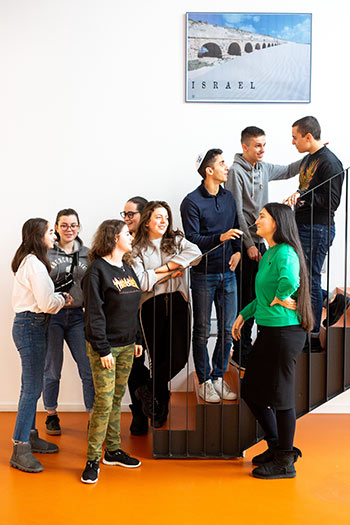
With their Sabbath dinner nearly over, 60 Jewish teens from across Germany are talking, laughing and singing. A joyous din echoes through the conference center where they are gathered in Bad Sobernheim, a spa region about an hour southwest of Frankfurt.
Asaf Gruenwald, a religion educator, interrupts the chatter with a question. “Pretend you’re meeting a Jew for the first time,” he says. “What would you ask?”
Silence descends. Then the kids start chiming in: “What’s that thing on your door, like a little box?” “Why is the Torah called the Torah?” “Are Jewish men only allowed to marry virgins?”
A wave of laughter follows the last question. Finally, Nick, a lanky, Russian-born high school student, answers his own query: “Nowhere in the Torah does it say you should, or shouldn’t.”
The teens are trainees for Likrat (Hebrew for “toward”), a program sponsored by the Central Council of Jews in Germany that introduces Jews and Judaism to non-Jewish students throughout the country. The young volunteers will eventually visit classrooms, at the invitation of educators, where they will talk about themselves and their Jewish identity.
“For non-Jewish pupils, Likrat is often their first chance to experience a real Jew, live and in person,” says Daniel Botmann, 35, managing director of the Berlin-based Central Council. “Likrat provides a chance for straightforward exchange. It also provides tools for Jewish teens on how to react to anti-Semitic situations.”
In workshops at the training weekends, participants confront questions and challenges that might come their way in a classroom. They discuss hot button issues like support for Israel and Jewish practices such as circumcision and kashrut. They also touch on topics much on teenagers’ minds, like dating. The training not only gives them more knowledge about Judaism and Israel, Botmann says, “but it also brings them soft skills, like conflict management and rhetorical skills. It’s a win-win situation.”
Likrat is one of several cross-cultural programs—some geared for students, others for adults—that have developed in Germany in recent years. Some are run by mainstream Jewish organizations and synagogues; others by independent groups or individuals.
These programs, a number of which partner with the German government, aim to overcome stereotypes and combat anti-Semitism. Crimes linked to a hatred of Jews increased by 10 percent in 2018, with 1,646 offenses reported, according to preliminary government figures released in February. The data show a 60 percent rise in physical attacks, with 62 violent incidents recorded, up from 37 in 2017. Ahead of International Holocaust Remembrance Day on January 27 this year, German Chancellor Angela Merkel called on all Germans to ensure “zero tolerance” of xenophobia and anti-Semitism.
Programs like Likrat take on extra significance in Germany, where postwar generations have confronted the history of the Holocaust with varying degrees of intensity. There are remarkable cases of non-Jews reaching out to Jews who had escaped Nazi Germany and establishing bonds with them, their children and grandchildren. But often, they approach Jews with extreme caution, borne of complicated feelings of guilt or responsibility. Or, they don’t approach Jews at all.
Before World War II, Jews were an integral part of German society. Of the approximately 500,000 Jews listed in the prewar census, more than half had fled to other countries by the start of 1939. After the war, some 25,000 Jews—mostly Eastern European survivors—remained in Germany following the disbanding of displaced persons’ camps.
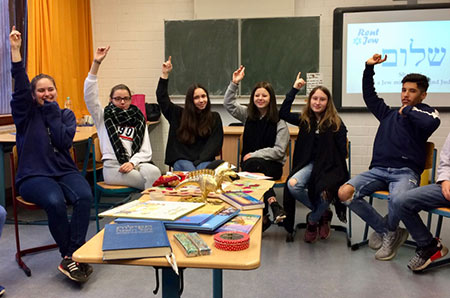
Today, around 200,000 people of Jewish background live in Germany out of a population of 83 million. Most of the Jews have come from the former Soviet Union since 1990. About half are affiliated with Jewish communities. The ratio alone suggests that most Germans have never knowingly met any Jews. Many are curious, judging by the popularity of Jewish museums, cultural and film festivals, and open houses at synagogues.
“The interest in all things Jewish among non-Jews in Germany has to do with the trauma of being the descendants of the perpetrators,” says Nicola Galliner, founder and director of the Jewish Film Festival Berlin & Brandenburg, which is in its 25th year and is highly popular among non-Jews. “It is very important for them to find out who are the Jews who were slaughtered in the millions just for being Jewish.”
Jews have an almost 1,700-year history in Germany, so “it’s nearly impossible for Germans to explore local history without constantly stumbling upon facets of Jewish life,” says Deidre Berger, director of the American Jewish Committee office in Berlin. But “Jews are not only part of history in Germany. They are a vital part of the fabric of German democracy.” Jewish leaders often speak out against discrimination aimed at any minority group, and are at the forefront of protecting the religious freedom of Jews and Muslims to practice rituals such as circumcision and kosher or halal animal slaughter.
“Judaism is in some way present—if not as a reality, then as a word that is very mysterious—deep within the European subconscious,” says Likrat founder Alfred Bodenheimer, a professor of Jewish studies at the University of Basel in Switzerland. This profound presence “goes back much further than the Holocaust, almost throughout the history of Christendom.”
Bodenheimer came up with the idea for Likrat while working as an educator with the Basel Jewish community in the early 1990s. In 2003, he got funding from the Swiss Jewish umbrella organization to train about 20 people aged 16 to 18 as ambassadors of Judaism. Today, Likrat International operates in Switzerland, Germany, Austria and Moldova. A new program is in the works in Belgium.
Bodenheimer says it is very important to teach the teenagers to not “represent some abstract idea about Judaism but to represent themselves, their own outlook on being Jewish, their way of keeping the laws or not.”
The project is not related to or part of Holocaust education, nor should it be, he adds: “Young Jews, born after the year 2000, may not be pressed into the role of representing anything or anyone related to the Holocaust. This would contradict the whole intention of meetings between non-Jewish and Jewish peers. This does not have to mean, of course, that the question of approach to the Holocaust may not come up in the conversations. But it should not be intentionally connected to this interaction.”
What happens in classrooms when Likrat visits is a kind of positive shock, he adds, noting that for more than a decade, students in Germany have used the word Jude as an insult in the schoolyard. Usually the insults are aimed at anyone, regardless of their background. But some Jewish parents in Berlin, for example, have switched schools for their children as a result of harassment.
Of course, anti-Semitism is a problem that mainstream society needs to address, officials say, especially considering Germany’s history. Recognizing this, the German government, in May 2018, appointed a special commissioner, Felix Klein, who is not Jewish, to develop programs to combat anti-Semitism. At the same time, non-Jewish educators, clergy and others continue reaching out for Jewish partners in their own efforts to overcome stereotypes and hatred.
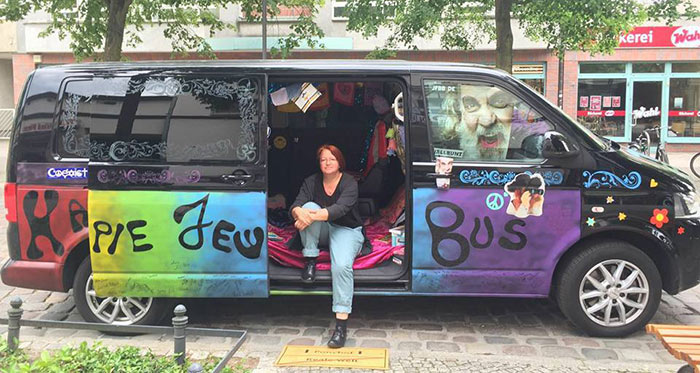
Among their potential allies are Rent a Jew, an effort supported by the Munich-based European Janusz Korczak Akademie and the Jewish Agency for Israel, which sends Jews to meet with groups of non-Jews; the Happy Hippie Jew Bus, a colorfully redecorated Volkswagen bus that Berlin-based artist Anna Adam drives around as an icebreaker on wheels; and Jewish volunteers in “Welcome Classes” for new refugees from Muslim countries.
“You can’t generalize about what motivates people’s interest,” says Adam, 55. Her wry 2002 exhibit at the Jewish Museum of Franconia in Fuerth, “Feinkost [deli] Adam,” included a device that allowed visitors to check their blood pressure while saying the word “Jew.”
Her Happy Hippie Jew Bus—the name is painted on the van in vibrant, 1960s-era-style letters—is filled with Jewish odds and ends, from a plush children’s Torah toy to a real shofar, that spark discussion. Adam travels around Germany, meeting people at schools, museums, public squares or marketplaces, disarming them and making them laugh. “People are very curious because they’re not used to seeing something so colorful and happy associated with Jews,” she says.
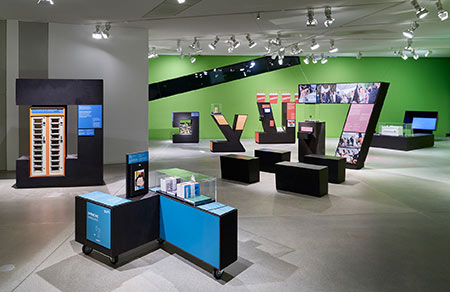
“Overcoming angst about meeting Jews is an ongoing task of the Jewish Museum Berlin,” says curator Miriam Goldmann, whose current exhibit, “A Is for Jewish,” provides an alphabetic tour of current Jewish life in Germany. With installations that depict everything from student projects to the 613 commandments, the exhibit shows that Jews here “are alive and kicking and shaping their lives.”
The Jewish Museum Berlin touched a nerve back in 2013 with its exhibit “The Whole Truth.” It included an open, transparent display case in which various Jewish guests took turns sitting and answering questions from visitors. News media quickly dubbed it “Jew in the box.”
“It caused a real shit storm,” recalls Goldmann, until people understood what it was all about. Then, Jews in Germany and from elsewhere volunteered for the role. “They said, ‘I do it all the time, I am constantly answering questions. So I can do this in the museum.’ And visitors liked it.”
On a winter evening in Berlin, Esther Knochenhauer, 34, a technology consultant professionally and a volunteer with Rent a Jew, pulls up a chair in front of some 20 non-Jewish, middle-aged adults in a Protestant conference venue. The visitors have come on an educational trip from Schaumburg, several hours east of Berlin, to visit the city’s Jewish sights. For many, this is their first encounter with a Jew.
“You might be a bit shocked by the name Rent a Jew,” Knochenhauer says to the assembled group. A member of Berlin’s Jewish community, she got involved with Rent a Jew after hearing that there was a group that “lends out Jews. ‘Oh, that sounds great,’ ” she recalls thinking. In Germany, many students associate Jews with the Holocaust, and some have met survivors in their classrooms. “But I always thought it shouldn’t always be about that. We Jews are living here, we are part of the society,” she explains in an interview.
Rent a Jew is “about getting to know Jewish people,” she tells the audience. “People want to see us.”
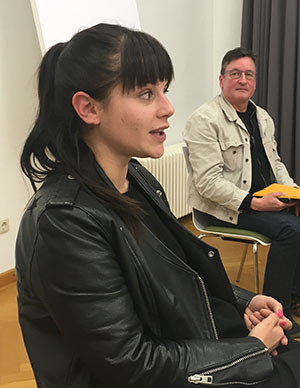
“And to touch you,” chimes in one woman, eliciting laughter. The ice has been broken.
When Knochenhauer mentions stereotypes, such as that all Jews are rich, or that they killed Jesus, another woman comments: “We also learned that in school.” Over the course of an hour, Knochenhauer answers questions about Jewish traditions, Israel, gender roles, head-coverings for men and women and differences between Jews born in Russia and those in Germany. When asked about anti-Semitism, Knochenhauer says the topic must be put on the table, even for kids.
Anti-Semitism “is everywhere in our society,” and non-Jewish children should be told that it is not O.K., she explains. She adds that for Jewish kids, it’s important to tell them what they might encounter so “if something happens they don’t get so scared.”
In a Berlin classroom, she relates, someone once asserted that Jews don’t pay sales tax in Germany. “My answer was a question: ‘How does it work? I’d be all for it. I’d pay 19 percent less!’ ”
Itai Axel Boeing, a retired schoolteacher who attends Berlin’s Fraenkelufer Synagogue, also helps educate non-Jews. Last year, the Berlin-based Kreuzberg Initiative Against Anti-Semitism asked him to address a Welcome Class, a government-sponsored program for young refugees, as part of their introduction to diversity in Germany. Since 2015, more than a million refugees—most of them Muslim—have come here from countries such as Syria, Afghanistan, Iraq and Nigeria. Though they have already learned some German, the Welcome Class has interpreters.
There is a general concern among Jewish leaders that some of these new immigrants harbor hatred toward Israel and Jews learned in their home countries. Boeing, who has encountered more curiosity than discomfort, says he hopes “that through these encounters they might change their attitudes.”
For their part, Likrat participants prepare to meet attitudes of all kinds: They go through a rigorous training, including workshops and sessions with Muslim and Christian peers. Over the last couple of years, about 100 new trainees have joined.
Days after their final training session in Bad Sobernheim, two participants, Mosche, 16, and Karolina, 17, visit their first school together. At the high school in Rastede, in northern Germany, they are welcomed by teacher Michael Luttmer and members of the school club For Peace; then they meet with Luttmer’s ninth-grade class.
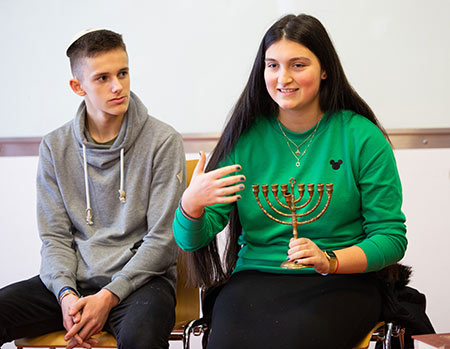
Karolina and Mosche begin by introducing themselves. They both attend public schools. She likes chemistry and biology, he likes math and sports. That already gets nods from their peers. Mosche belongs to a liberal Jewish community in Oldenburg, not far from Rastede; Karolina, who calls herself Karo, lives further south in Osnabrueck and is part of the local Orthodox community. Mosche sometimes drives to synagogue on the Sabbath, because it’s so far from home. Karo is strict—she prays three times daily, sometimes on the train to school if she oversleeps.
Both Mosche and Karo have non-Jewish friends. “It’s sometimes hard when everyone around you is eating pizza, and you say, ‘Hey, can I have a cola or some water?’ ” Karo says after explaining the laws of kashrut. “So I make pizza at home. It’s hard to be a perfect Jew, but I try!”
Mosche tells the students that he likes going to the Jewish youth center. “Sometimes one feels alone as a Jew in Germany, because there are so
few of us,” he says.
How do Mosche and Karo perceive anti-Semitism, the pupils want to know.
“I once heard someone call another kid a ‘shitty Jew.’ He had nothing against Jews, but just wanted to insult him,” says Mosche, who admits to being most worried about the recent rise of a far-right political party, the Alternative for Germany. “What can you do except go to the classroom and show that we are not aliens with three eyes?”
“Someone once threw a penny on my desk and said, ‘You Jews are always greedy for money,’ ” recalls Karo. “I asked, ‘What are you trying to say?’ ”
Growing worries about anti-Semitism in the general society had led Luttmer to request the Likrat visit. “It seemed like a good time to have a talk, to give young people a chance to meet,” he says. And the feedback has been great, according to the teacher. “Mosche and Karolina have already agreed to come back.”
“I know much more about Jews now,” Lara, a 16-year-old student, wrote in an email after the visit. “I have a lot of new—and above all, correct—information.”
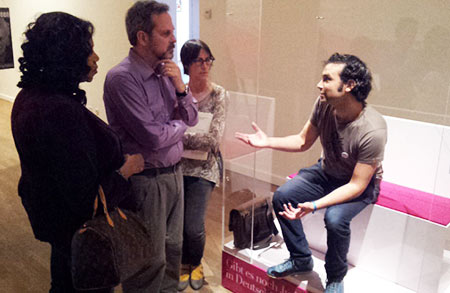
Viola, 16, used to think most Jews were old. “Now I know that there are also many young Jews, so Judaism became much more relevant for me,” she wrote after the meeting. Besides, “Mosche and Karo were super nice and it was a fun discussion.”
And Liv, also 16, says she was surprised to learn about the laws that traditional Jews keep. “Karo said she doesn’t touch boys,” she wrote in a follow-up email. “This surprised me a lot. I had never met a Jew before. I was excited and nervous, but when they came in and we said hello, I quickly got it, that it was a conversation between peers. That calmed me down again.”
For her part, Karo is also positive about the session. “I was really happy about it,” she says afterward. “I think it’s very important, since people usually connect Jews with German history. But we say, ‘Hello, here we are!’ ”
“Every encounter is different,” says Mosche, who adds that he wished the pupils had asked more personal questions about everyday life as a Jew in Germany.
Parents and teachers say they notice the difference that the training makes—at home and in the classroom. Mosche’s father, Yehudah, is convinced that Likrat has helped his son “build self-confidence and public speaking skills. And of course it also helps him develop his sense of Jewish identity.”
Karo’s mother, Nonna, says the program fills an important need. “Now, whatever confrontations or questions come up in school or in public, she is really prepared.”
These projects may seem like drops in the ocean in the ongoing fight against anti-Semitism, but they do contribute toward normalization, however slowly, insists Botmann of the Central Council.
“For decades there have been confrontations with dead Jews, with the Holocaust and persecution, memorials and memorial days,” he says. “It’s far less comfortable for people to confront a living Jew, with a personality and individuality, feelings and convictions.”
Toby Axelrod is a Berlin-based correspondent for the Jewish Telegraphic Agency.










 Facebook
Facebook Instagram
Instagram Twitter
Twitter
[…] confrontations with dead Jews, with the Holocaust and persecution, memorials and memorial days,” Daniel Botmann of the CCGJ, who declined to be interviewed for this article, told Hadassah in 2019. “It’s far less comfortable for people to confront a living Jew, with a personality and […]